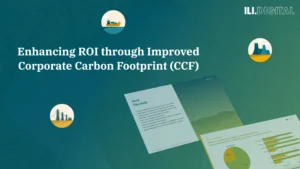- Industries

Transforming Financial Instructions
With Innovative Digital Solutions - Services

Reduce Corporate carbon Footprint with gecco2
- Insights

Corporate Carbon Footprint and ROI
- About
- Industries

Transforming Financial Instructions
With Innovative Digital Solutions - Services

Reduce Corporate carbon Footprint with gecco2
- Insights

Corporate Carbon Footprint and ROI
- About
EN
Not many issues were as controversial last summer as the appearance of e-scooters in German cities.
Lime is one of the first and largest providers of this form of micromobility in Germany.
In Berlin, we met Fabian Ladda, who is responsible for implementing Lime services in German cities.
Our discussion ranged from quality contracts with cities, scooter innovation cycles, sustainability, to the weirdest places where users leave their scooters after a ride.

ILI.DIGITAL: Please describe your responsibilities at Lime.
Fabian Ladda: Public relations is a pretty fitting term for it. I focus on partnerships with cities. Lime is currently operating in fifteen German cities under voluntary agreements, our memorandums of understanding (MOUs), with each of them. In Cologne, for example, we have what’s referred to as a “quality agreement.” In general, they define the terms and conditions for mobility providers. Some cities hold round table meetings regularly to develop and revise such policies. My job is to manage the partnerships, and be aware of what’s going well and what not. That’s a rough summary of my job, but this being a start-up, one helps wherever help is needed. I believe we currently have 30 or 40 job openings in Germany in the areas of marketing, communication, business development, etc.
When did you enter the German market?
We started off as Lime Bike, but today it’s just Lime. We began with electric bicycle sharing back in April 2018, in Berlin and Frankfurt. We were the first operator of e-scooters in the German market. The Small Electric Vehicle Ordinance (eKFV) was enacted on June 18, 2018, and we started our e-scooter service at large scale three days later. Another three days, and more providers had joined in, and since then growth has been extremely strong. Germany immediately became the second most important market for Lime in the world. We established ourselves in 15 cities in less than three months. Our growth is simply phenomenal, compared with other mobility services like car or bike sharing. Even after many years, these businesses are still not as far as we have come with e-scooter sharing.
Which factors help you decide on where to launch?
We’ve already routinized this process. Lime has been operating for two years now, and we are aware of the de facto requirements to enter an e-scooter sharing business in each city – so we know what to look out for before we offer services. On one hand, the city must have a certain population density. Then it’s important to check if there are any other mobility services, like local public transit (which is usually best for commuting), car, or bike sharing. The bicycle infrastructure is also an important factor. Two-thirds of our users claim that they would use Lime more often, if safe bicycle lanes existed. Other aspects like tourism, restaurant density etc., also play a role and are closely intertwined. When we decide to offer e-scooters in a new city, we set up a team there, along with a warehouse, mechanics, etc. The scooters must be serviced and repaired regularly. If you do not have the needed staff, you can’t start the business. Good, centrally-located, affordable warehouses are no longer easy to find in the current economic environment. Hence, one must consider numerous factors.
But most importantly, the city must be ready, and that’s where I take over. There are still cities in Germany that lack policies on e-scooter sharing. Thus, even if we wanted to, there’s no way we could open a business there. Right from the start, it was always clear that there must be a partnership between the cities and Lime. We only launch our services in a city if the conditions and expectations are clear, a contact person exists, and if we can coordinate closely with the city. We decided not to offer our services in some cities, because we anticipated misunderstandings regarding e-scooter sharing.
“There is no other industry offering as many hardware innovations as we do.”
For example?
From time to time, cities set limits on e-scooters. At first, it may sound like a good idea to cap the number of e-scooters, but that creates a dilemma for scooter providers. For example, if I get a permit for 500 or 1,000 scooters, I’d place them in the city’s downtown and the central station, where there are bars and cafés, but not in the suburbs. As a result, no scooters will be available at locations to resolve the first-mile/last-mile issue. Let’s view this from the standpoint of Berlin, as an example. With a limited number of scooters, it would not be possible to reach any suburbs beyond the range of the public transit system (S-Bahn network). That’s why we prefer a guaranteed minimum coverage approach, such that every locality gets a certain number of scooters every morning. This adds additional value in terms of the transportation policy, by meeting mobility needs and allowing Lime to run its business. The concept that “We will set an upper limit, and the scooters will be under control” – is clearly a misconception.
You mentioned that you have signed voluntary agreements with each city. Could you name three things that are usually included in them?
Sure. The first one is the parking situation. There are around 15,000 e-scooters and 16,000 e-bikes in Berlin, a city with 1.2 million cars. Everyone has become so used to cars parking for 23 hours on the roadside that no one realises how much space is dedicated to car parking. Scooters, however, are new and many people got quickly annoyed. Even though just one car parking spot easily fits 15 scooters. Nevertheless, cities want us to implement no-parking zones to minimize the negative awareness of scooters. Hence some places are banned for scooters, for example, historic monuments. Additionally, we require our scooter users to take a picture of how they parked. This improves how riders behave and decreases unpleasant experiences for residents with scooters.
Next is the issue of data sharing: We deliver information to the cities for each month on the number of users, the average distance of a scooter ride, etc. The average scooter ride in Germany today is 1.9 kilometers. But we now have many first-time riders who just want to try out an e-scooter for a short distance. As these users decrease over time, the average driving distance will rise to up to 3 kilometers. Cities have a great interest in data about how people move around.
The third and always a quite prominent topic is our responsibility to teach our users how to use e-scooters. No e-scooter user can claim he/she was not informed about the ban on driving a scooter with more than one rider, or driving on sidewalks. We always point out the traffic rules and make it clear that driving an e-scooter is subject to the same rules on the road as a car, in terms of drinking and driving, etc.
A funny anecdote: Driving scooters with more than one rider wasn’t a problem so far in any other country. Strangely, Germans love riding together. To comply with this legal regulation, we added a pictogram, just for the German market, that illustrates the ban on tandem-riding.
When you launch in a new city, do you also use trial balloons with a small number of scooters?
We don’t need to anymore, because we have over two years of experience and are present in over 120 cities – which makes us the most established player in this field. We know what is important. We only go to cities where we can establish a good relationship and get a reasonable MOU. If we decide to roll out in a city, it takes some weeks to find a warehouse and hire the staff. Hence, we don’t bring 2,000 scooters right away, but kick-off with just 300 to 500, and see how that goes. Afterwards, we scale up and adapt depending on the demand. You could consider this a trial balloon, but the goal is not to find out whether our mobility service works at all, but rather how it works best. For each roll-out, we make sure we do it properly.
After we launch in a city, we constantly adjust the number and location of e-scooters, add or remove parking bans, etc. We use an algorithm to identify scooters not used within 24 hours. Therefore, if we had allocated five scooters to one such location, for example, we might offer only three scooters the following week. It’s a learning process that never stops.
Micromobility and e-scooters
Can you calculate when an e-scooter starts to pay off? You mentioned that a scooter is serviced several times a week. This calls for manpower and you need a warehouse to store and repair scooters. I imagine it’s rather difficult, especially because the rides are quite affordable. Do cities support you financially?
No, we get no subsidies at all, unlike some bike-sharing companies. We are already profitable in many cities, a fact that other mobility companies cannot claim. The reason for this is the extremely high demand. There were days in June through August, and some in late autumn, when scooter batteries were completely dead by 4 pm. We sometimes had days with 7 to 10 rides per scooter, and the scooter battery just died on the road. Yet, other days are different, because ours is a seasonal service.
I’d like to add that this whole profitability topic was questioned for a long time, because the first-generation scooters lasted up to 4 months only. This has changed radically. Nowadays, their durability is at least 16 months, and a scooter will have a second, third, and fourth lifecycle. Subcontractors recycle our batteries, and thus even if the scooter is scrapped completely, the battery is taken out and used in a new scooter. We have warehouses with 20 to 30 boxes of just spare parts, new tires, new brakes, etc. There is currently no other industry offering as many hardware innovations as we do. After two years, we are already at scooter model number 17 or 18. If you hear about such short lifetimes, they were true for models 1 through 4, maybe number 5, but for current models they are far from true. For comparison, let me give you some numbers. The first scooters weighed around 10 kg, maybe 12 kg, but the new ones weigh over 20 kg. The first ones were made of hard plastic, the new ones are crafted from aluminum only. The first generation had exposed cables; the new ones are fully wired inside the pole to reduce the risk of damage.
When did you join Lime?
I came on board in January 2019. Back then we only offered bike sharing, which was manageable. After that I helped get type approval for our scooters and focused on city launches. It has been 10 months, but it feels much longer.
In the U.S. and other European countries Lime has been offering scooter services for some time now. Was there something in the launching process in Germany that was different than in other countries?
Yes, the scooter itself. We are present in over 120 countries, while the generation 3 scooter is available in 15 countries. For a long period of time, generation 3 was available only in Germany. To get the scooter on German roads, we needed type approval from the Federal Motor Transport Authority. We had to modify our scooter completely with advanced brakes and lights too. It is safe to say that the German scooter has set world standards. It is the toughest and safest scooter in the world and making it road-worthy wasn’t a task to be underestimated.
The German market is the most important one for us, and in no other country did we achieve acceptance and such high growth as quickly as here. After just 11 weeks in Berlin, we reached the one million ride target, which means a Lime scooter was unlocked every 15 seconds. That’s an absolute world record. And we still have very high usage in October, even though the weather is not very pleasant.
E-scooters are highly accepted. Germans buy one million e-bikes yearly. I believe that something has transformed in the whole electric mobility debate: Germans tend to still be a bit critical of electric cars, asking questions like “What is its range,” “How often do I have to charge,” etc. These questions have been around for six years, but the enthusiasm for these products is there and we can see that.
“We reached one million rides in Berlin After just 11 weeks. This means a Lime scooter was unlocked every 15 seconds.”
During negotiations, do cities promise that if you implement micromobility with e-scooters, they will expand the infrastructure?
Sadly, not yet. We have the same demands as, for example, the German Bicycle Federation (ADFC). We also call for expansion of bicycle infrastructure. Colored lanes are not infrastructure, bicycle lanes must be protected with barrier posts. The 30 km/h zones should be expanded for more road safety.
Parking management is another issue. You pay an administration fee of € 20.60 to park your car for two years in Berlin. In comparison, Stockholm charges € 827. We are accused of our scooters being parked everywhere, and my answer to that is, “Let’s convert a few car parking spaces for micromobility users.” Here in Berlin, I always have to hunt for a spot to park and lock my bicycle. Why shouldn’t we convert a car parking space every fifty meters, so that seniors, disabled people, and kids have space? Unfortunately, no cities is yet considering to transform car parking spaces for micromobility.
After each ride, the user gets the message “Thank you very much, your ride was CO2 neutral”. Could that be a bit misleading…?
We are still purchasing offset certificates for our entire operations. As a first step in Germany, we are in the process of getting electricity from renewable sources for all our warehouses, something we already did in France. Durability of the scooter is the second key aspect, because each part should last at least 16 months. This makes sense ecologically and economically. Our CEO recently announced that we each part of our scooter must become 100% recyclable.
We are in the process of using more and more e-trikes and e-vans managing our scooter fleet. but there are no good products on the market. A few models do exist, but with inadequate range. Options in this sector would be extremely helpful now.
We introduced exchangeable batteries. We do this partially in Paris, where we send out cargo bikes carrying batteries, and they replace dead ones with new ones. At some point we hope to have a big fleet of cargo bikes on the road exchanging batteries. That’s our goal, and we are trying to get there right now. The scooters are green, everything about them should be green too, and clients should feel good every time they drive a scooter.
I heard Berlin residents say: “As locals, we do not use e-scooters as much as it’s portrayed online, only foreigners and tourists rent them. Honestly, we are rather annoyed by this invention.” What were the most negative comments you got in the beginning?
The most common one, which I always hear, is that e-scooters are toys for children and tourists. Not too long ago, we surveyed all German cities and determined that the average age of a scooter user is 35 years. Yet, when you see how the scooters are parked or where they are left, it makes you wonder why adults behave that way. It is annoying, because you’d expect that mature 35-year-olds would know traffic laws. Tourists make up less than a 20% of our riders in Germany, Berlin has the highest number of tourist users, but it’s still below 30%. In Berlin-Gesundbrunnen, where I live, there are very few tourists, just like in the Schöneberg and Rummelsburg. It may simply be people’s perception. You see what you want to see. I might also be deluded in a way, because e-scooters still catch everyone’s attention whne they pass by. We have gotten used to cars, bicycles, and even Mobikes, which were an attraction two years ago, and though their numbers haven’t dropped, nobody talks about them anymore. Among our users, 30% use Lime to commute regularly to work or school; they’re not tourists. We know that 60% use Lime to get to public transit stops. For them, it’s not just a fun ride, but part of their every day’s mobility mix.
30 million car trips every day are less than 2km long – in Germany alone. This is staggering. Another 25% cover just 2–5 kilometers, which is also complete madness. It means that 50% of car rides could be replaced by bicycles and scooters. I recently read a new statistic: there are 75 million bicycles in Germany, and 4 million new ones are bought each year. You would assume that everyone would use a bicycle for short distances under 5 kilometers, but it still isn’t happening. The bicycle has been on the market for two centuries, but somehow people still prefer their car over the bike. I think that in this whole debate about the “Verkehrswende”, we forget that many people are lazy, and seek comfort or whatever you may wish to call it. That’s why they prefer cars over bikes. This is where the e-scooter shines, because it means no sweating, no muscle power needed. With the push of a button, ride your personal flying carpet and cover a 10-minute walking distance in an instant. If we could only swap a small percentage of short car rides with e-scooters, we’d make real progress.
Let me highlight one last statistic on this topic: 15% of our e-scooter users considered using a car, taxi, or Uber for the planned ride, and yet chose a scooter because it was in sight. This is a 15% shift away from driving a car. The added value is already there.
What are the three weirdest places in which you have found your scooters?
Let me think. Almost everywhere. We’ve found them in trees, even though they weigh more than 20kg. In Greece, people thought that we had installed iPhones in the scooters – Disclaimer: We only use SIM cards with GPS which explains how we know when scooters are parked in no-parking zones. When the rumor circulated about an iPhone being in the green case of the scooters, someone cracked 20 cases. I have no idea why it took that person 20 attempts to realize that there were no iPhones.
“ride your personal flying carpet and cover a 10-minute walking distance in an instant.”
The media showed pictures of scooters are being thrown into the river. Does that happen often?
A few scooters ended up in the water, but vandalism is still within limits in Germany. It’s much worse in some other countries, which isn’t great, but Germany’s not a problem. What is rather funny is what people use our scooters for. At my presentations, I always have a photograph from Poland showing someone buying a fridge at a flea market and transporting it with an e-scooter, whilst here in Berlin I saw a couch being transported on one.
You worked at Uber before you started at Lime. What is it that fascinates you about urban mobility?
Yes, mobility became my passion ever since my job at Uber. If you take a close view of cars, they represent the biggest expenditure in a household, or the second biggest if you own a house. People are willing to spend € 400–500 every month for a vehicle that just stands around 23 hours/day and loses value continuously. With those extra € 400–500 each month, you could be a mobility king or queen and get a local public transit pass, use bike sharing, car sharing, scooter sharing, and you would even be able, every now and then, to take a taxi and let yourself be chauffeured around. Best of all, you’d still not use up the entire € 400–500. It fascinated me so much back then that people simply overlook this simple fact, that I decided I had to open their eyes.
I talk constantly about urban mobility, because we have so many cities, and urbanization doesn’t stop. Almost 70% of the world’s population now lives in cities. There are so many people who live in Berlin or its outskirts and own a car, simply to visit their parents once a year, a concept I consider absurd. The idea that you gain your individual freedom by owning a car is probably the best marketing story in the whole world, right after the story that says we must build cities around cars. I am not against cars, just against personal car ownership. I believe that there are amazing multimodal options offered by Lime, Miles, Uber and others and if you really need a car just go to Sixt or Europcar, which are more than adequate for a weekend car rental.
Back then, when this concept started to fascinate me and I still worked for Uber, I absorbed lots of statistics. One was on how to transport more people by car. Currently the average occupancy of a car on the road is 1.3 persons, which is a poor rate of utilization, knowing that up to five persons fit in one car. Micromobility with scooters has an excellent utilization rate with 100% each time. I know, two people are not permitted on a scooter, but that would even double the utilization rate to 200%, which would fulfil every traffic planner’s dream. Another absurd thought is that we must have tons of metal around us to transport one person by car, versus only 20 kilograms with a scooter. Such things will always fascinate me.
From your point of view, is there something that could be a game changer for mobility?
In the Nordic countries and in Holland, people use bicycles for almost all their needs, regardless of the distances and weather conditions, and there are hardly any accidents. In our country, the number of deadly bicycle accidents is on the rise. A game changer would be safer infrastructure, i.e., an infrastructure designed not for cars, but for people. But this sounds much simpler than it is. Ways to achieve this include expanding the 30 km/h zones, banning cars from city centers, or building highways for bicycles and e-scooters. We need to redo the entire infrastructure. If you look at our road crossings today, you’ll seldom see turning lanes for bicycles, and bicycles are rarely placed in front of cars which would boost their safety. Car drivers often end up stopping/parking on bicycle lanes which is endangering all the cyclists that have to pass by using the car lane. This could be prevented thanks to barrier posts. Finding solutions to improve the safety of all road users isn’t rocket science – it just requires real infrastructure.
“The idea that you gain your individual freedom by owning a car is probably the best marketing story in the whole world.”







